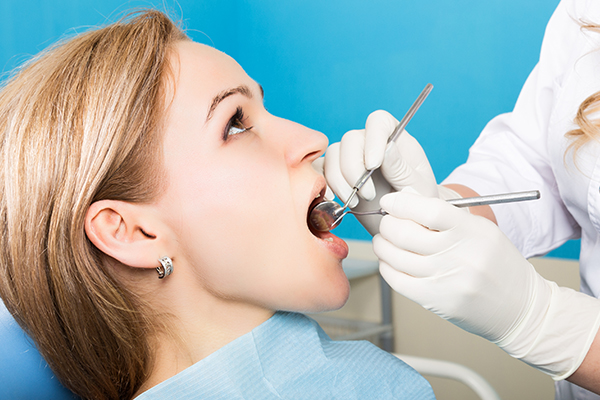In this article:
Plaque is essentially a slimy layer of oral bacteria that lodges on your teeth, gums, tongue, dental fillings, crowns, dentures, and the inner lining of your oral cavity in general.

It tends to thicken over time as multiple layers build upon each other, and eventually, it becomes visible as a pale-yellowish shadow on the teeth.
Untreated plaque can solidify into a brownish substance called tartar, which is much harder to get rid of. The accumulation of plaque and tartar increases the bacterial load in your mouth, which invites a number of oral health problems.
Causes of Plaque and Tartar
Negligent or improper oral hygiene leads to the accumulation of food debris in the mouth, which ultimately paves the way for plaque and tartar formation, among other dental problems.
Your mouth is naturally populated with several strains of bacteria, both good and bad. These microorganisms feed on the sugars and starches found in food particles and release acidic by-products during the process, which chip away the tooth enamel over time.
If you clean your mouth improperly and continue to consume a diet rich in carbohydrates or sugar on top of that, these bacteria will proliferate and blanket your gums and teeth. This bacterial film that usually starts at the gumline and extends all across the surface of your teeth is referred to as plaque. (1)
Your saliva contains certain minerals that are readily absorbed by the bacterial plaque, giving it an increasingly hardened and calcified finish. The chalky-white substance that results from the increased mineralization of plaque is referred to as tartar or calculus.
Signs and Symptoms
Plaque formation is usually a result of poor oral hygiene and can easily be identified if you just run your tongue over your teeth. The dental plaque feels sticky and somewhat coarse and even becomes visible as a pale-colored layer lining the enamel of your teeth.
Plaque formation is particularly true for people who skip brushing their teeth every so often. Given that the inner surface of the teeth is usually not cleaned as rigorously as the frontal surface, this type of negligence can lead to an increased buildup of plaque on the backside of the teeth.
Medical Treatment

The only standard treatment for most cases of plaque or tartar accumulation is debridement. It is the process of getting your teeth thoroughly cleaned by a professional.
Your dentist will most likely perform the following deep-cleaning procedures depending upon the extent of the damage:
1. Scaling
The dentist will scrape off the dental plaque and tartar from the teeth enamel as well as from above and below the gumline with the use of specially designed tools.
2. Root planing
The dentist will remove the corrosive acidic compounds produced by the oral bacteria to prevent further buildup of tartar and tooth decay. This process also involves smoothening of the exposed surfaces of your teeth.
3. Tooth polishing
The dentist will buff off the superficial stains and soft plaque deposits from the enamel of your teeth to impart it a lustrous finish.
Diagnosis of Plaque and Tartar
To determine the extent of plaque accumulation, your dentist may perform either of these two tests:
- The first method involves chewing on a special tablet that contains a red-colored pigment, which is released in your oral cavity and stains any area that may be ridden with plaque.
- Another method involves the use of an ultraviolet plaque light. You will be given a fluorescent solution to swish around your mouth that has to be spat out, followed by a mouth rinse with clean water. The doctor will then examine your oral cavity under the UV light, which will make any trace of plaque glow bright yellow-orange.
Of the two diagnostic tools, the UV light exam is generally the more preferred option since it does not leave any stubborn red stains in your mouth.
Complications Related to Plaque and Tartar
Excessive plaque and tartar buildup in your mouth can set the ground for more serious oral health issues, such as:
- A gradual weakening of the dental structure, often resulting in cavities
- Tooth sensitivity and toothache
- Gingivitis, which is a gum infection characterized by inflammation and bleeding of the gingival tissue
- Periodontitis, a severe form of gingivitis where the damage extends to the bone and ligaments that hold the teeth in place and can even result in complete tooth loss (2)
- Foul breath, also known as halitosis
- Abscesses in the mouth
- Implications on your overall health – The bacteria from your mouth can spread further into the body and jeopardize your cardiovascular health and increase the risk of preterm labor, among other concerns.
When to See a Doctor
If you are consistent with your oral hygiene routine and mindful of your diet, it becomes quite easy to limit the accumulation of plaque and tartar in your oral cavity. However, if you fail to register any success despite appropriate self-care measures, a visit to the dentist becomes compulsory.
Besides, it is always advisable to get an expert opinion about the extent of the damage and what needs to be done to remedy it. Your dentist is better equipped to detect hidden plaque and remove it, especially from areas that are beyond your reach.
Expert Answers (Q&A)
Answered by Dr. Shikhar Saxena, DDS (Dentist)

Tartar is usually a hard, chalk-like substance that is formed after calcification of the softer creamy plaque. Both plaque and tartar are generally yellowish-white. Tartar can have darker brownish areas depending on the diet and smoking habits.
Generally speaking, plaque will form on your teeth regardless of the diet. However, foods rich in carbohydrates will cause a more rapid buildup of plaque.
No, but not removing it will definitely loosen your teeth over a period of time.
No, most TV commercials make a false claim. Plaque can only be removed by mechanically scrubbing it off (brushing, flossing, cleaning at a dental clinic, etc.).
Yes.
Brush and floss your teeth a minimum two times a day. Also, plaque disclosing agents can help in ensuring that all areas on the teeth have been cleaned well.
Final Word
The oral bacteria found in plaque increase the toxic load in the mouth, paving the way for several periodontal (gum) problems. The only way to prevent the buildup of dental plaque and calculus is to remain dedicated to your oral hygiene regimen.

- Was this article helpful?
- YES, THANKS!NOT REALLY



